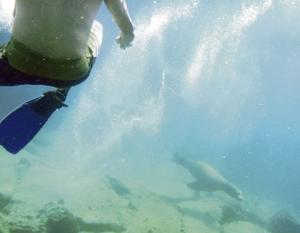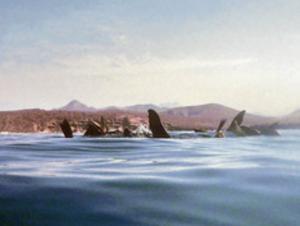Published in the Ocean Watch column, Honolulu Star-Advertiser © Susan Scott
November 14, 2011
I have had some memorable experiences swimming with California sea lions here in the Sea of Cortez, but none as thrilling as two incidents last week. One was a tad too thrilling. As I snorkeled, I watched a bull sea lion charge my husband. Thirty minutes later a flotilla of female sea lions calmed my pounding heart with a precious gift: They let me float with them.
>
Photo by Susan Scott
A bull sea lion leaves a wake of bubbles after it charges a swimmer.
Craig and I had left our sailboat, Honu, in a safe anchorage and puttered our inflatable dinghy, Baby Honu, to Seal Rock, or Roca Lobos. (A seal is a “lobo marino” in Spanish.) This well-named islet off the Baja town of La Paz is a resting place for sea lions as well as a popular diving and snorkeling site.
I had been hoping to swim with the sea lions there, but these creatures are accustomed to boats and people. One sleepy female glanced toward us when we arrived and immediately resumed her nap. The rest ignored us totally.
No problem. Fish of all sizes and colors swarmed the orange and yellow coral reef surrounding the island. The snorkeling was heavenly but we soon stopped. Staring at us intently from deep water at the reef’s edge was a young male sea lion.
We knew he was young because of his small forehead bump and his body size, impressive but only about half the 800 pounds or so mature males can reach.
Because breeding season for California sea lions runs from May through July, bulls’ testosterone levels are low at this time of year, and the male’s scrutiny caused us no alarm. The bull kept his distance as he swam, watching us watching him but showing no hint of aggression.
Then Craig tipped his fins over his head and dived. The bull charged.
It happened so fast we barely saw it. That sea lion torpedoed toward Craig with such speed that the stream of bubbles it was blowing looked like a white banner trailing behind. But like the slower, friendly charging games of females and pups, the immature bull veered off just before it reached Craig’s chest. The animal hung in the water for a moment and then disappeared into the deep.
We swam to the other side of the island, where a raft of six to eight serene females floated together, bodies touching, flippers raised above the waterline. Called rafting or sailing, this behavior is a sea lion method of cooling off.

Photo by Susan Scott
Female sea lions raft.
Those unafraid females let me drift so close to them I was able to dive down and see their lumpy brown body mass from below.
Before I made that free dive, though, I checked the area for bulls.